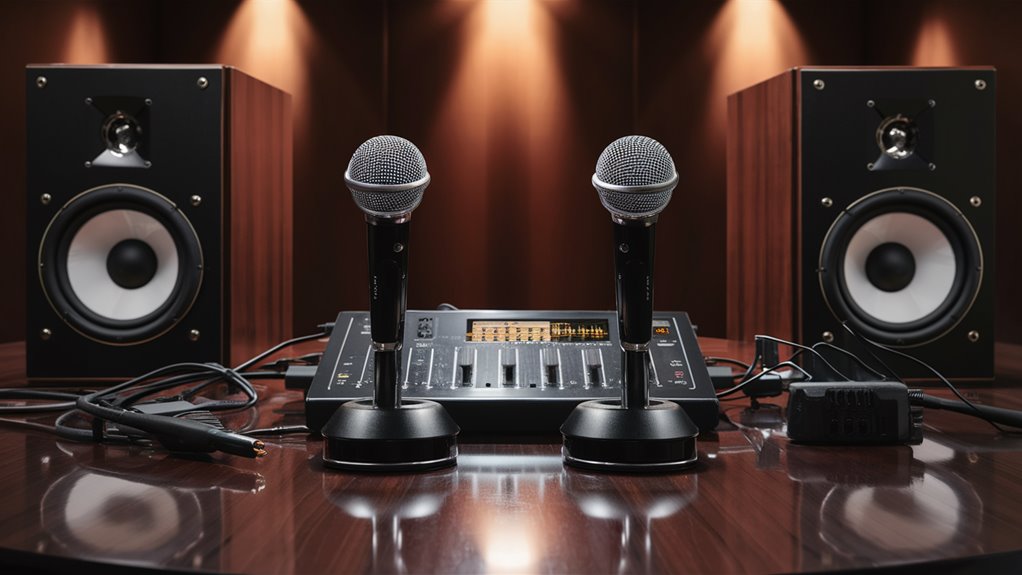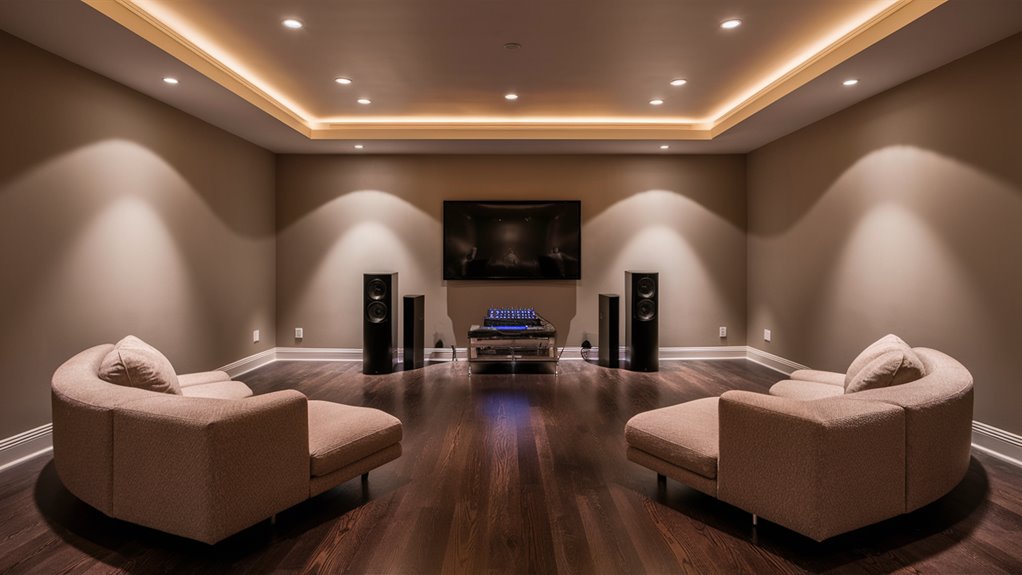What Makes a Great Karaoke System?

The best karaoke setup mixes top-notch parts and great tech to give you a great sing-along time. At its heart, a fine audio chip runs at 24-bit/48kHz with smart DSP skills to make sure the sound comes out clear.
Main Parts
Top mics that catch a good range of tunes from 50Hz-15kHz grab your voice clearly. A strong three-part speaker setup pushing 100W RMS per part offers the right mix of power and detail, making sure each note fills the room just right.
Tech Needs
Two screens make things better, while a big song list that gets new tunes often keeps things fun and new. Smart sound setup with well-placed panels fixes room sound well, cutting out bad echoes and noise.
Links and Setup
Good XLR outs and lots of ways to hook up make sure the system fits well with other sound gear. The setup’s smart user area should let you adjust key things easily, while keeping sound clear all through.
The gap between plain and fine karaoke setups is in these key tech details and how well they work together, giving a top-level fun time that both fun singers and keen ones will love.
Key Sound Bits for Karaoke
Audio Main Parts
Three main bits set the sound in karaoke: audio chip, speakers, and mic’s sound booster. Each bit has a main role in making top-level karaoke show.
Digital Sound Work
The audio chip runs the show, setting up digital sound work (DSP) and mixing music with voice. Pro setups need chips that back 24-bit/48kHz work at least, with set sound adjusters for both tunes and voices. Must-haves include echo, reverb work, and smart voice cut tech to turn normal songs into karaoke ones.
Speaker Needs
A three-part speaker build gives great sound via bass parts, middle-range bits, and high bits. Pro setups ask for speakers that can do 100W RMS per part at least, giving a full range of tunes (20Hz-20kHz). The link between parts makes sure tunes split up right, cutting out warping and keeping sound clear.
Mic Boost Specs
Pro mic boosters lift your singing with 48V ghost power, exact loudness control, and very low noise (-128dB or less). Top units offer both XLR links and 1/4-inch inputs, for many mic types. Two-way use lets two sing at once, while keeping sound clear all through.
Must-have Mic Bits for Pro Karaoke
Core Tech Details
Good performance in a pro karaoke setup hangs on picking mics with the best specs. Three key tech bits make for great voice catch: tune range, sound path shape, and signal-to-noise count. Mics with a tune range of 50Hz to 15kHz bring out the best in your voice, from deep notes to high tunes.
The heart-like sound path is best for pro karaoke, giving great sound cut-off and little side color. A signal-to-noise ratio of 65dB or more makes sure your voice amps up well.
Smart Wireless Tech
UHF band setups between 470-698 MHz give the best sound send with less mess than old VHF ways. Must-have built-in parts include built-in breath filters and bump handling setups for cutting sounds and pop control. Smart loudness control (AGC) stops signal cuts while keeping loudness even. Two-way receivers with own volume setups let more than one sing at the same time, giving pro-level options for many performers.
Song List and New Adds
Top Guide to Pro Karaoke Song Lists

Building Your Main Song Collection
Pro karaoke setups need a big song list of at least 10,000 okayed tracks across many types of music. A good mix keeps a 70/30 split between well-known hits and special bits, making sure there’s something for everyone while meeting specific tastes.
Content Links and Format Handling
Work with big karaoke music groups like Sound Choice and Chartbuster for okayed music flow. Set up a strong list handling system that supports many formats:
- MP3+G files
- MP4 stuff
- CDG ways
- MIDI files with words in sync
List Care and Quality Checks
Start auto-update setups to keep the list current through:
- Monthly adds of 50-100 new songs
- Regular checks of old tracks
- Spotting trending tunes
- Quality checks of:
- Sound sync
- Word rightness
- Sound levels
Data-led List Growth
Start full tracking setups to pick content well:
- Watch what users ask for
- Look at what’s hot
- See music types spread
- Handle data tags well
- Make search work better
This planned way makes sure the list gets better all the time while keeping high quality and making users happy.
Show and User Spots in Modern Karaoke Setups
Making the Look Work
High-detail screens with glare-cut tech are key in pro karaoke systems, giving clear view in all light settings. Touch-ready spots mixed with usual hands-on controls make a strong double system that tops in trust and user feel. This two-way method makes sure things run smooth even in hard spots.
Two-Screen Setup Musts
Pro karaoke builds need smart putting in of two different screens:
- Singer Screen: Shows tune help, timing marks, and up-next words
- Main Screen: Shows current words and active back scenes
Top systems let you set custom screen needs like:
- Word size tweaks
- Color mix changes
- Better contrast
- Back scene choices
User Area Control and Handling
Clever menu setups let you move through core spots well:
- Live sound level checks
- Quick key changes
- Line handling tools
- Effects handling spots
Move-based work lifts work speed while keeping show going. The mix of visual feedback setups gives sharp control over sound bits and effects handling, making sure sound stays great through the show.
Pro Karaoke Link Guide
Main Sound and Show Links
System links are key for top Karaoke Playlist show. The mix of both digital and analog spots makes sure it works well and can be trusted across many place setups.
Pro Sound Outs
Set sound links are key for great sound flow:
- XLR outs for pro PA systems
- 1/4-inch TRS set outs for studio-level gear
- RCA links for home sound setups
Show Link Needs
All-type video outs are a must for flexible setup choices:
- HDMI out for high-detail shows
- VGA links for old monitors
- Basic video for old setups
- Two-screen work with own outs
Input and User Spot Options
Mic Setup
Pro mic hook-up needs:
- Four XLR ins at least
- Own loudness setups
- Ghost power for sound mics
- Wireless get-along
Digital Links
New user spots lift system give:
- USB spots for keeping and add-ons
- Net links for list reach
- Wireless mix for stream without wires
- 3.5mm help input for backup ways
Pro Karaoke Room Make and Setup Guide
Room Size and Sound Plan
Room size and sound traits are main parts that set how well your karaoke setup works. Start by working out the full room size and checking wall stuff to make sound better. Sound fixes should be smart and all over.
Best Room Build
The tried 60/40 layout rule tops both show and crowd spots:
- Put the show zone along the long wall
- 60% for crowd sitting
- 40% for stage and gear
- Keep at least 8 feet to the ceiling (10-12 feet is best)
Main Sound Spots
Show Area Bests
- Set up sound boards at first echo spots
- Put bass traps in room corners
- Work out speaker spots by room size
Sound System Needs
- Rooms under 500 sq ft: Two 12-inch speakers and a bass add
- Bigger spots: More side speakers or delay poles
- Sound must spread even all over
Safe and Air Flow
Main room set spots:
- Clear ways for quick get-outs
- Right air setups
- Smart gear spots
- Fit with safe rules
Top Sound Fixes
Start pro-level sound control:
- Control echo in big listen spots
- Handle bass in corner spots
- Put in stuff to soak sound at key points
- Set boards to even out sound
